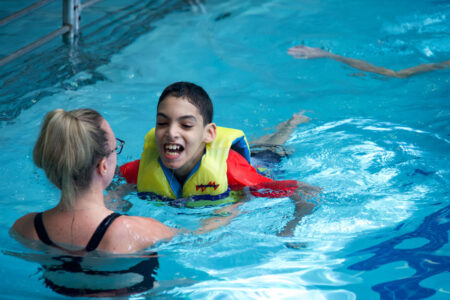Going for a dip in a pool is not just fun—it’s also a form of therapy! The indoor heated pool at ADAPT’s Lawrence Ave. location, which was previously closed for renovations, recently reopened in January.
A few of the children of Lawrence Ave. were the first to hit the pool, accompanied by lifeguards and trained teacher’s assistants. The kids kicked their feet, threw basketballs, and relaxed in the pool’s heated water. However, their trip to the pool wasn’t just for fun. The water also provides the perfect setting for aquatic therapy.
What is aquatic therapy? Jennifer Monahan, a physical therapist working at the Lawrence Ave. location, describes it as any therapy or exercise with the added component of water. It differs from regular physical therapy because it eliminates much of the pressure on a participant’s joints, providing them relief from the weight of maneuvering on land. In particular, it is ideal for people with neuromuscular or musculoskeletal disorders such as muscular dystrophy, rheumatoid arthritis, fibromyalgia, and other conditions that affect the muscles, joints, and/or bones.
“[The water] makes it easier for [individuals] to move easier and perform exercises that are less painful because it takes off that force on the joints,” Jennifer said. “The water kind of gives you extra assistance so that you can assist them in a different exercise or activity, and they can perform better with the buoyancy of the water.”
Each individual’s aquatic therapy routine is personalized to their particular diagnosis and abilities. Some individuals we support use the water to help increase their mobility by walking in the pool with the support of a life jacket. Others use the reduced pressure and the warmth of the water to manage spasms and muscle tightness by decreasing stress on the body.
“[It]’s going to relax them so that they take better breaths,” Jennifer said. “They’ll be able to move a little bit easier.”
One individual Jennifer has been working with is Zayden, a student at the Brooklyn School-Age Program, who Jennifer describes as having “a lot of spasms and movements.” After even one session in the pool, she sees a noticeable difference in Zayden.
“Now, he’s relaxing…he’s taking better breaths and swallowing,” she said.
In addition to the Brooklyn School-Age Program, 175 Lawrence Avenue also houses Brooklyn Day Hab 1 and 3, enabling adults from these programs to also take advantage of Sheila’s swimming lessons. Sheila Romero, the pool’s operator as well as a lifeguard, teaches swimming skills to adults we support to eliminate fears that might be associated with deep water.
“Many people were afraid of the deep end, and now they are comfortable,” Sheila said. “Some now go into the deep water without me holding them and have even learned how to swim.”
Beyond conquering fear, swim instruction is also invaluable in building connections between individuals and their instructors.
“It’s also about trust,” Sheila added. “I’ve worked with people over the years and now they trust that they can do what I teach them. It feels good to connect with them that way.”
Overall, the many benefits of water therapy and swimming lessons for both children and adults with developmental disabilities are well worth a relaxing dip in the pool.
“[The children and adults we support] are all so happy,” Sheila concluded. “They laugh a lot and enjoy being in the water.”


